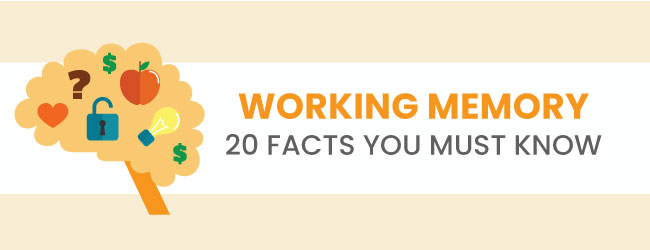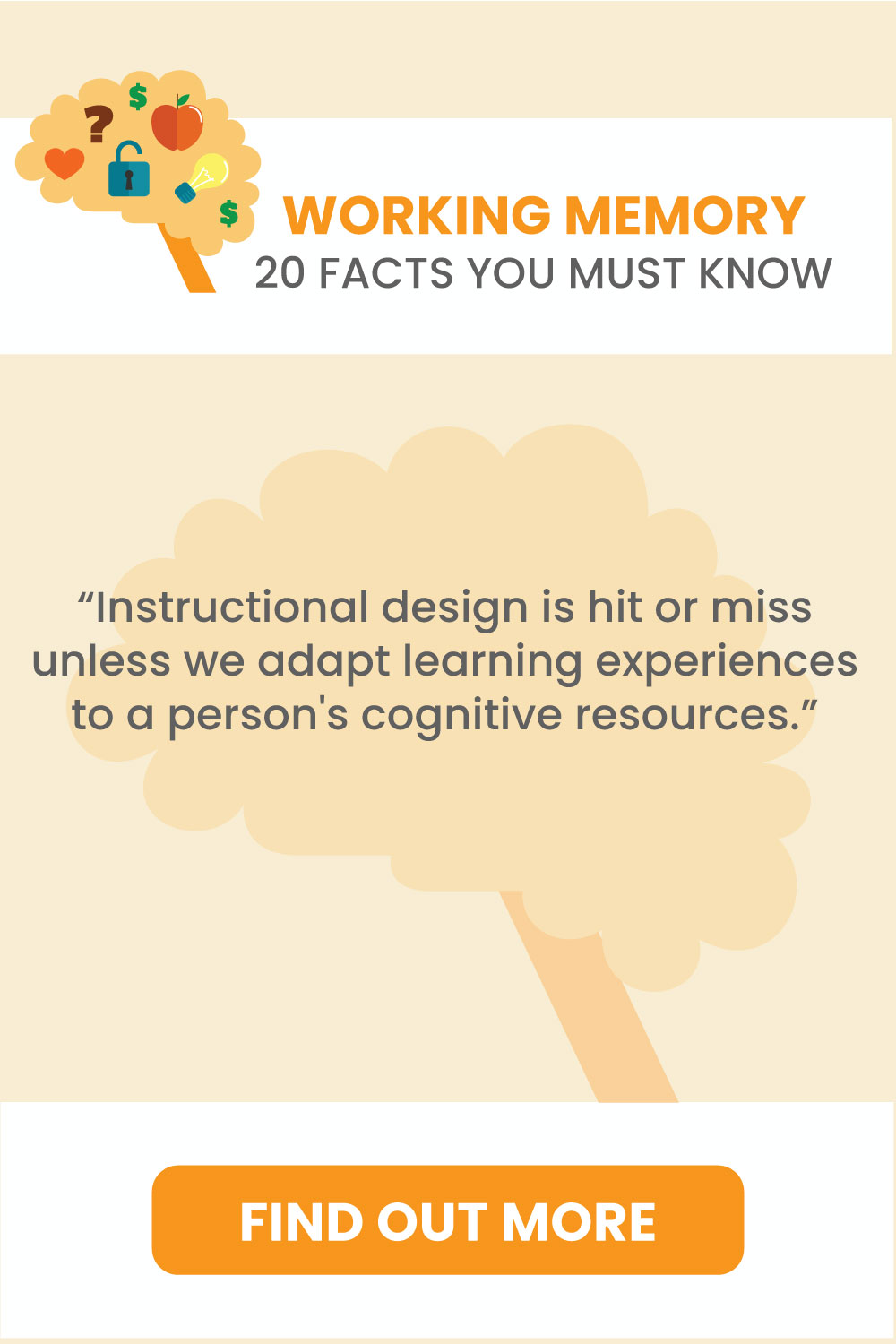
Understanding the characteristics of working memory when designing learning experiences is essential. Instructional design is hit or miss unless we adapt learning experiences to a person’s cognitive resources.
Current research demonstrates that working memory (a theoretical structure and process) has a limited capacity. Here are twenty facts about working memory as it pertains to learning.
The Basics
- It is now common to use the term working memory to more or less replace short-term memory. This terminology focuses on its functionality rather than its duration. Others differentiate between working and short-term memory. They refer to short-term memory as the brief storage of information. And working memory as involved with both storage and manipulation of information.
- Working memory can be thought of as the equivalent of being mentally online. It refers to the workspace and active process of manipulating information.
- No one physical location in the brain seems to be responsible for what we know as working memory. But several parts of the brain seem to contribute to this cognitive process.
Capacity of Working Memory
- Working memory is characterized by a small capacity. Researchers think that we can process 3-4 elements of new or interacting information at one time.
- Because learning experiences typically involve new information, the capacity of working memory makes it difficult for many people to assimilate more than around four to five bits of information simultaneously.
- The capacity of working memory depends on the category of the elements or chunks as well as their features. For example, we can hold more digits in working memory than letters and more short words than long words.
- The limitations on working memory disappear when someone works with information from long-term memory (permanent storage). Researchers theorize that we organize information in long-term memory into schemata. Schemata are higher order structures composed of multiple elements that help to reduce the overload on working memory.
Duration of Working Memory
- New information in working memory is temporary. It is either encoded into long-term memory or it decays or is replaced.
- Information in working memory has a short duration of around 10-15 seconds unless we rehearse it or attend to it (Goldstein, 2010).
- Similar to the capacity issue, it takes mental effort to hold information in working memory for an extended time and can also be a cause of cognitive overload.
Interactions with Long-term Memory
- There is a continuous transfer of of information between long-term memory and working memory—both retrieval and transfer.
- We retrieve information from long-term memory into working memory in order to make sense out of new information.
- We transfer or encode information that we pay attention to and integrate it into the knowledge structures of long-term memory.
Individual Differences
- Current research demonstrates that individual differences in working memory capacity may account for differences in performance of information processing tasks, like reading and note-taking.
- In studies with children, those who have a poor ability to store material over brief periods of time (difficulties with working memory) fail to progress normally in tasks related to literacy.
- An individual’s developmental age and level of expertise probably account for differences in working memory. For example, facilitating learning with certain strategies can be helpful for novices but detrimental to experts. See Novice Versus Expert Design Strategies.
Cognitive Load
- Cognitive load refers to the demands placed on working memory regarding storage and information processing.
- The learning task imposes an intrinsic cognitive load on working memory. The design of the instruction imposes an extraneous load on working memory that designers can control.
- Intrinsic load refers to the demands placed on working memory when learners acquire new knowledge. It involves conscious cognitive processing to construct schemata and most likely assists learning.
- Cognitive load theory states that traditional instructional techniques can overload working memory because they don’t account for intrinsic and extraneous load. Instructional designers can facilitate learning by considering and accommodating different loads.
References:
- E. Bruce Goldstein. Cognitive Psychology: Connecting Mind, Research and Everyday Experience. Wadsworth Publishing, 2010
- Patricia L. Smith and Tillman J Ragan. Instructional Design, Wiley, 2004.
- Tamara van Gog et. al., Instructional Design for Advanced Learners. ETR&D, Vol. 53, No. 3, 2005, pp. 73–81.
- Wolfgang Schnotz and Christian Ku?rschner. A Reconsideration of Cognitive Load Theory. Educ Psychol Rev (2007) 19:469–508


You’d have to go to a more medical-oriented site to get the real answer. In my non-medical observations, it seems as though people who have an impaired working memory or short-term memory have a difficult time forming new memories.
How does the working memory disorder affect job/work tasks for employees? Is this disorder a preempt to Alzheimer’s?
Hi Tracy,
Thanks for offering your website. I’ll check it out.
Best,
Connie
Hi Connie, Great summary! It is wonderful to see people’s growing interest in working memory and how it is so important to education. My own research expertise is in working memory (see my research on my website) and I would love to connect with you!
Wow Rachel!You’ve made my day. I hope you get a good grade.
Connie
Hi Connie,
I am a middle schooler who is doing a science project on human memory and I found this information to be very helpful! I have looked through site after site to find the information I need and I found this to be the best! Thanks for the help, I deffinately want to get a good grade! Keep the good work up Connie!
– Rachel(:
Hi ID Dean. Thanks for pointing out this inconsistency! The Cognitive Load article has some of the latest research, so I’ll make an adjustment to this article. But the research might vary depending on the participants’ working memory, because the capacity and duration of working memory apparently varies in people, which affects how people learn. Pretty fascinating stuff!
Best,
Connie
Connie,
Thank you for your summary of WM points. It was very insightful and I appreciated seeing it broken into major points. Since your article focuses on WM, would you say that you accept the view of two-store memory model with regards to information coming in to a sensory register which moves into an active or working memory which then associates with long term memory until meaningfulness is achieved and the new information is transferred into long term memory? I find this memory model to be easily understood in its explanation of how learners encounter new information, decide whether to act upon it in working memory and encode the information by incorporating it into long-term memory.
Your inclusion of cognitive load theory was new information for me, so I took a look your blog entry on “What is Cognitive Load”. Here you state that “information in working memory lasts only around ten seconds”, but point nine of the current article you state that working memory is around 20 seconds. I was curious if this was a typographical error or if you are using differing sources or theories. As with any developing research, different theories state opposing opinions; i.e. Miller (1956) declares that working memory holds 7+ or -2 pieces of new information while, more recently , Cowan (2001) determines four chucks of information to be the limit. Is this the position that you have taken?
Thank you again for the wealth of information!
Hi Joe,
I think Multimedia Learning edited by Richard Mayer is a good choice as there are chapters by many researchers. Ruth Clark’s e-Learning and the Science of Instruction might be more practical, though. Then there are several eLearning books that might not cover cog psych, but are practical, such as Horton’s eLearning By Design. I’m hoping to review a few of these books one of these days. If you find something that you would recommend, please let us know.
Connie
Hi Connie,
I am also curious about practical applications, particularly in the field of creating instruction materials (online learning courses). Can you recommend a book for that? Thanks!
Joe
Hi Darlene,
So glad you found my blog! I love your comments. I think a lot of instructional design theory is about avoiding cognitive overload. Strategies like chunking information, progressively revealing content, real-world but simplified interactions, providing job aides and adding graphics that externally represent internal processes (like decision trees, flowcharts, etc.) are all ways that help avoid cognitive overload.
Connie
Hi Connie,
I’m a graduate student in an ID&T program so I’m brand new to the field. An application for the Learning Theories class I’m taking required that I subscribe to three blogs about Instructional Design and then ultimately contribute to either one of the blogs I originally subscribed to or to one my fellow learners found.
I found your blog from a fellow learner and I really like it. The blogs I’d originally referenced were good, very full and of high quality, but so much of the material is beyond my novice understanding. And there was nothing I felt confident about contributing to.
Your blog here about Working Memory is something I’m actively engaged in studying and I’m finding it really fascinating.
You wrote:
“Cognitive load theory states that traditional instructional techniques can overload working memory because they don’t account for intrinsic and extraneous load. Instructional designers can facilitate learning by considering and accommodating different loads”
Would you have any opinion or advice about how one prevents cognitive overload in working memory? Four to seven pieces of information (Omrod, 2009) isn’t much at all and in this day and age, with the onslaught of rapid-fire imagery from every direction, I’m sure we’re being overloaded on a regular basis. I wonder how can we design to protect the learner from overload?
References:
Ormrod, J., Schunk, D., & Gredler, M. (2009). Learning theories and instruction
Hi Greg,
Thanks for your comments. In answer to your question, “What do IDs watch/plan for to keep the cognitive load in the germane range and minimize the extraneous load?” — often IDers just need to focus on the learning outcome as it applies to the workplace. What tasks will the learner be performing? Then include only the content (including interactions) that support the tasks that people will perform.
I know this can be difficult in some fields, like medicine, where the healthcare worker needs a very large knowledge base of information in order to diagnose and treat. When working with SMEs in these cases, I explain how and why “less is more.” Then ask for their help in slimming things down to the essentials. That’s another approach.
Connie
Nice WM summation, Connie. Your points 7-9 interrelate and are the reason point 12 is needed in any learning task. A continual juggling of new information and known facts in WM develops the meaningfulness between them and facilitates the encoding you mention in point 13. All good so far, but what do IDs watch/plan for to keep the cognitive load in the germane range and minimize the extraneous load? In another of your blogs, Characteristics of Adult Learners, one of your commenters mentions breaking the content down into ‘small bites’ to stay within the learner’s attention span or focus. As a past curriculum designer in the military and now a graduate student of ID, breaking a learning task into meaningful sub-tasks or activities has been something I have paid attention to for many years. The Cognitive Load aspect is a new wrinkle, as mentioned by Sarah, so I will also check the book and begin some WM ‘juggling’ of my own.
Hi Sreemla,
My understanding is that when the representations from LTM are activated, they are brought into WM, which is what allows us to understand the world. I haven’t read about another name for this memory store, but it’s possible there is one. I wonder if you could find out from one of those Q&A sites, where you ask questions of experts. If you do find out, please let us know.
Nice to hear from you,
Connie
Pretty neat! Very helpful to quickly understand important aspects of WM.
However, environmental cues will activate a part of LTM, which is then accessible to WM. Then, the working/active memory holds a representation of recent events, like noting information in an advertisement. So, does this kind of working memory constitute a separate memory store or is it just an “activated” portion of LTM?
Hi Sarah,
I think Smith and Ragan’s book, Instructional Design, does have practical applications. But you know, that might be in the eye of the beholder. So you might want to check it out first in your university library to see if that’s the book for you.
Best,
Connie
Thanks for this great summary! I am a student in a graduate program in IDT, (in career transition at the moment). I especially appreciate your section on ‘Cognitive Load’, very interesting & I had not encountered the theory before. I’m going to check out the reference you listed. Are there also practical applications of the theory in the book you cited?
Hi Dianne,
You’re right, I should do that. Please check back in a few days and I’ll try to round them up.
Connie
Nice summary. Would be really interested in the citations for the studies you reference.
Thanks for catching those errors, Michael. I’ve corrected them. I blame it on too little sleep and too little time. =]
Great synopses of information processing and cognitive load theory. You do have a couple of typos in #18 and #19. There is no term “extrinsic load.” The correct term is extraneous load. I’m still bookmarking now for my students. 🙂
~michael